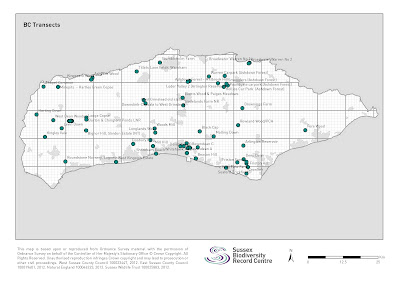Following on from my
last post about transect recording, it's worth mentioning another UK-wide butterfly survey - the
Wider Countryside Butterfly Survey - also run by the
UK Butterfly Monitoring Scheme (UKBMS).
Transects need to be walked week in, week out, year in, year out, by the same volunteers. It's hardly surprising then that they tend to be clustered around places where people
actually want to walk - places like nature reserves and
protected sites. So the Wider Countryside Butterfly Survey was launched in 2009, as a partnership between
Butterfly Conservation, the
British Trust for Ornithology and the
Centre for Ecology and Hydrology, to assess the changing status of butterflies
in the wider countryside - to provide an indicator of the general health of our environment.
In Sussex the Wider Countryside Butterfly Survey is coordinated by
Penny Green and, very briefly, this is how it works:
The method involves making a minimum of two visits to a randomly
selected square between May and August to count butterflies along
two 1km survey lines running roughly north-south through the square.
So, compared to starting a transect, it's not a major time commitment. And there's the added bonus that you can enter your data online if you want, as soon as you get home.
Interested? If you want to find out more, it's well worth checking out the Wider Countryside Butterfly Survey
2011 newsletter, which came through my letterbox this weekend. It was great to read that, last year, Sussex achieved the second highest level of survey coverage nationally - with 26 squares surveyed. Well done to Penny and all the volunteer surveyors! And Sussex scored the most diverse square too, with 24 species seen over three visits in one square on the South Downs. Woohoo! ( ... With aspirations to be a proper scientist, I feel I must resist the temptation to claim this result thereby PROVES that Sussex is the best county in Britain for butterflying... Tho', of course, we know it is ;)
But anyway - aside from enjoying a bit of jockeying for positions on the county butterfly recording league tables - it was a sentence at the bottom of page 3 in the newsletter that really jumped out at me and highlighted why the Wider Countryside Butterfly Survey is an important companion to the UKBMS transect surveys:
"None of these maximum counts are exactly earth shattering given that they are culled from a large amount of effort all across the UK. They highlight the fact that, away from nature reserves and other special areas, ordinary members of the public are rarely if ever likely to encounter the clouds of butterflies that can be such a wonderful spectacle of the natural world."
A sobering thought. This data really shows us why it's important to adopt a
landscape scale approach to conservation. And the results provide us with a tool to illustrate to government and landowners and everyone what state our countryside is in.
The good news is that the landscape scale approach to conservation has been gathering pace for a while. Environmental organisations have known for ages that this is the way we need to go. Butterfly Conservation is delivering projects at the landscape scale to conserve target species - locally our own
Rowland Wood aquisition is an example of this kind of thinking. And the
Dukes on the Edge project, as well as the recently announced
South Downs Nature Improvement Area, are both landscape scale conservation projects aimed at boosting populations of
Duke of Burgundy butterflies (among other objectives). Wildlife Trusts are doing the same kind of things through their
Living Landscapes approach. And the RSPB too, with
Futurescapes.*
Even the government seems to be cottoning on, judging by the stuff they're saying in the
Natural Environment White Paper which follows on from the recommendations in
Making Space for Nature - the independent review of England’s wildlife sites. The press release issued by Defra when
Making Space for Nature was published was pretty stark in stating:
"We will not achieve a step-change in nature conservation in England
without society accepting it to be necessary, desirable and achievable."
The Wider Countryside Butterfly Survey is one of the tools we have for showing a step-change is
necessary. It's up to all of us to show that it's also desirable and achievable.
*
Mark Avery's running an intriguing poll at the moment asking, if you had to give your money to one environmental NGO - which one would you give it to? I'm glad I don't have to choose in real life.




